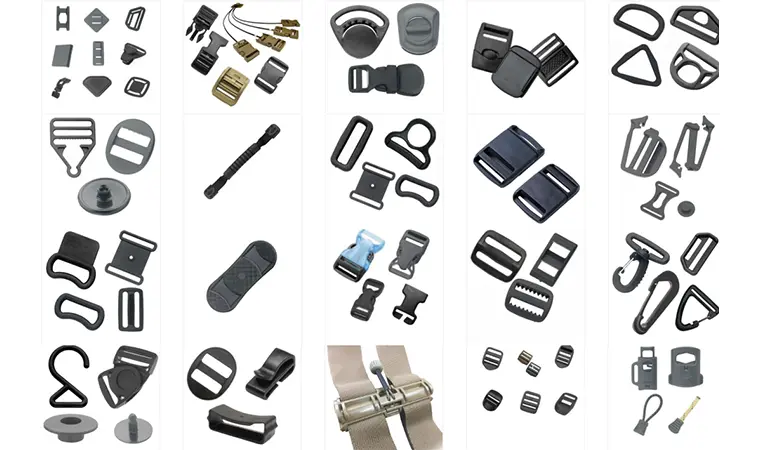For any product that relies on webbing—be it a load-bearing military vest, a rugged outdoor backpack, or a safety-critical pet collar—the hardware is just as crucial as the strap itself. A low-quality buckle that fails at a critical moment can compromise the entire product, damaging not only its function but also your brand's reputation. For B2B buyers, tactical brands, and government contractors, selecting the right hardware is a strategic decision that defines product success.
As a specialized manufacturer of webbing and accessories, we know that buckles are not just simple fasteners; they are precision-engineered components. This guide provides an in-depth look at different types of webbing hardware, analyzing material differences and applications to help you make the most informed sourcing decisions for reliability and durability.
Material Matters: Plastic vs. Metal Buckles
The material of a buckle is the primary factor determining its strength, durability, weight, and cost. Understanding the pros and cons of each is essential.
Plastic Buckles: The Lightweight and Versatile Workhorse
Plastic buckles, especially those made from Polyoxymethylene (POM) or Nylon (PA), are the most common choice on the market. They are widely used on backpacks, pet products, and outdoor gear.
- Advantages: Lightweight, corrosion-resistant (won't rust), cost-effective, and available in a wide variety of colors. High-quality POM buckles (from renowned brands like Duraflex or ITW) offer excellent strength and fatigue resistance.
- Disadvantages: Lower ultimate tensile strength compared to metal buckles and can become brittle in extreme cold.
- Sourcing Tip: Always confirm the material. Avoid cheap Polypropylene (PP) buckles, as their strength and durability are far inferior to POM and they are prone to cracking and aging.
Metal Buckles: The Symbol of Strength and Premium Quality
Typically forged from steel, zinc alloy, or aluminum alloy, metal buckles are the ideal choice for heavy-duty and high-end applications, particularly for tactical belts and premium hardware fittings.
- Advantages: Extremely high tensile strength and durability, able to withstand immense shock loads; provides a premium look and feel; available in sophisticated designs like the famous "Cobra Buckle."
- Disadvantages: Heavier, more expensive, and require a protective finish (like plating or coating) to prevent corrosion.
- Key Applications: Military belts, fall protection harnesses, heavy-duty cargo tie-downs, and other areas where load-bearing capacity is non-negotiable.
Common Hardware Types and Their Applications
Beyond material, the structural design of a buckle dictates its function. Here are some of the most common types.
1. Side-Release Buckles
This is the most classic design, consisting of a male and female part that clicks together and is released by pressing on the sides. They are standard on backpack sternum straps, waist belts, and pet collars.
2. Quick-Release (QR) Buckles
Designed for situations requiring rapid deployment or emergency release. QR buckles on military vests and tactical belts allow operators to instantly jettison their gear. The Cobra Buckle is a high-end example, famous for its incredible strength and reliable locking mechanism that will not open under load.
3. Adjusters, Ladder-Locks, and Tri-Glides
These components are used to adjust the length of webbing straps for a secure and comfortable fit. From backpack shoulder straps to camera slings, their presence is ubiquitous. It's crucial to select an adjuster with the right "grip" for your chosen nylon webbing or polyester webbing to prevent slippage during use.
4. D-Rings & Square Loops
These primarily serve as attachment or anchor points for hanging accessories, connecting straps, and more. Metal D-rings are often used for load-bearing connection points due to their high strength, while plastic versions are suitable for lighter-duty attachments.
A Sourcing Checklist for Webbing Hardware
When evaluating a hardware supplier, use this checklist to ensure you are receiving high-quality components that meet your specifications:
- Request Material Certification: Ask for a Certificate of Conformance (CoC) to verify the plastic is POM, not PP, and that metal alloys meet strength standards.
- Inquire About Tensile Strength Data: A reputable manufacturer can provide destructive break strength test reports for their hardware—a key indicator of performance.
- Inspect Surface Finishes: For metal hardware, check that any plating or coating is uniform and abrasion-resistant to ensure good anti-corrosion properties.
- Test for Compatibility: Always test hardware samples with your specific webbing to ensure a smooth feed and a non-slip grip after adjustment.
- Leverage One-Stop Sourcing: Choosing a supplier like us, who provides both a full range of webbing and matching hardware, ensures optimal compatibility and simplifies your supply chain.
Your Trusted Partner for Webbing and Hardware
The final quality of a product is determined by the reliability of its every component. The wrong buckle can render a well-made webbing system useless. With our deep expertise in webbing manufacturing, we are equally committed to providing high-performance hardware to match.
We offer more than just products; we provide a complete solution to ensure your product's performance and safety. Our quality control system and deep understanding of the requirements across various applications make us the ideal partner for your most critical projects.
Ready to source high-quality webbing components with confidence? Contact the TMG Webbing team to discuss your technical requirements and request a quote.

